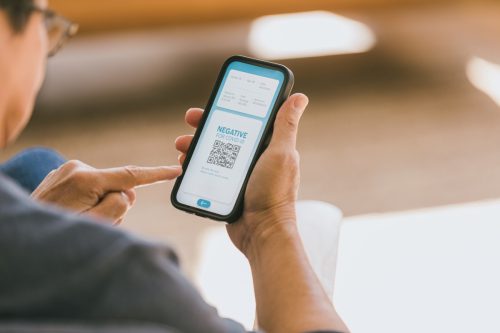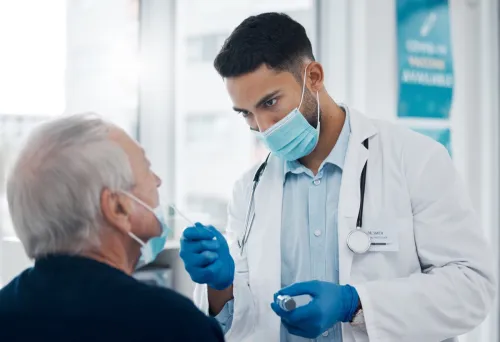It goes without saying that the COVID-19 pandemic has changed the way we travel. Case in point: nowadays, travelers often need to seek out COVID tests before hopping on a flight or cruise ship, and it looks like that policy is here to stay for the time being. While this is a policy for a very good reason—keeping yourself and other passengers safe—it does require a little extra planning. That’s why we gathered experts’ must-know testing tips to minimize any hassles and hiccups that might sabotage your getaway.
Whether you’re going to Dublin or Dubai, all international travelers need to get tested in their destination country before heading home to the U.S.—and to make matters a little more complicated, those results need to be from within 24 hours of your flight back. Depending on where you’re headed, you may also need to take a test before leaving. If you’re traveling within the states, you aren’t required to provide a negative COVID-19 test—although, the CDC advises that unvaccinated travelers get tested before departing and then again 3-5 days after they return. Even if you are vaccinated, you may still want to get tested for peace of mind.
Between packing your suitcase, making reservations, and planning your itinerary, you’ve already got a lot to worry about when preparing for a trip. But there’s no reason why COVID testing has to add any unnecessary stress to the experience—just keep the following essential expert-approved tips in mind for smooth sailing from start to finish. And for more travel tips, check out The 10 Best U.S. Cities Every Traveler Should See.
iStock
Almost every country requires a negative COVID-19 test and/or proof of vaccination for entry, including the U.S. However, the Centers for Disease Control & Prevention (CDC) recently updated its recommendations for domestic travel —per these guidelines, vaccinated travelers flying within the U.S. may not need to get tested, but unvaccinated travelers should get aim to get test results one to three days prior to travel. You’ll also want to verify which type of test is acceptable.
“Some airlines and countries have realized that antigen type tests are not as accurate as desired and have progressed to allowing molecular or PCR type testing only,” says Michael Blaivas, MD, Chief Medical Officer at Anavasi Diagnostics in Washington. “I have had multiple patients present saying they were turned away from a flight because antigen tests were dropped and molecular tests were now required. Confirm what test is acceptable to the country you are traveling to if they require a test result on arrival.”
The CDC advises checking the local requirements on testing—and while you’re at it, check the requirements for the specific airline you’re flying with. Since these requirements are constantly changing, it’s a good idea to check them for your destination as your trip draws closer, as well as for your home state shortly before you return. The State Department’s website features country-specific info about COVID-19 regulations, including important details about testing requirements and availability. William Lang, MD, medical director for WorldClinic in New Hampshire, also suggests checking out the tourism website for the country you’re visiting.
“Given the amount of time and money that is invested in international travel, it’s a good idea to work with an international health provider who is familiar with reviewing individual countries’ stated requirements and make sure that your interpretation aligns with who you are seeing on the tourist guidance,” he adds.
RELATED:
For more up-to-date information, sign up for our
daily newsletter.
 Shutterstock
Shutterstock
Having at-home COVID-19 tests already on hand can be super convenient, especially when any impromptu or last-minute travel opportunities come up. That said, the CDC has strict requirements for these COVID-19 self-tests.
According to the CDC, self-tests must meet the following criteria:
- The test must be a SARS-CoV-2 viral test (nucleic acid amplification test or antigen test) with Emergency Use Authorization (EUA) from the U.S. Food and Drug Administration (FDA).
- The test must include a telehealth video visit during which someone authorized by the manufacturer supervises the testing procedure in real-time.
- The telehealth provider must issue a report confirming the patient’s identity, the name of the lab or healthcare entity, the type of test, and the specimen collection date.
- Airlines and U.S. officials at ports of entry must be able to review and confirm your identity and the printed or digital documents with your test results.
- A few CDC-approved examples include the BinaxNOW COVID-19 home test, the Detect Verified™ test, and the Ellume COVID-19 Home Test.
Larry Snider, VP of Operations of Casago Vacation Rentals in Arizona, highly advises packing a few of these self-tests for your trip, particularly if you’ll be hopping between countries while you’re away.
“Keep these tests in your carry-on, as their functionality will decrease if exposed to extreme temperatures,” he says.
Just keep in mind that some countries may not approve of using foreign COVID-19 test kits that are not authorized or registered there, so you should contact authorities at your destination to check if your test meets the requirements.
“Also, make sure that the test result that you obtained is appropriately certified,” adds Lang. “For most countries, a certification of the result by any licensed health care provider is adequate, but others are very specific about requiring an actual laboratory certification.”
 iStock
iStock
So, you got your negative result, hopped on a flight, and landed safely at your destination. You can probably toss that test result now, right? Not so fast—the CDC recommends that travelers keep those results for a full 14 days after reaching their final destination in the U.S. That way, if you’re required to show it to a U.S. government official or a cooperation state or local public health authority, you’ll still have proof that you tested negative.
 Shutterstock
Shutterstock
If you’re planning a getaway outside the U.S., you’ll want to have a plan in place not only for securing a COVID-19 test before leaving but also before returning back home to the states.
TestForTravel.com is an excellent resource that allows you to search any international destination for local testing centers. You can also filter the search results by the specific type of COVID-19 test you need.
Looking for U.S.-based testing sites? Search the U.S. Department of Health & Human Services database to find local health centers and pharmacies offering low or no-cost testing.
READ THIS NEXT: The Best Tourist Attraction In Every State.
 iStock
iStock
As part of their services, some travel agencies and tour operators are now offering clients COVID-19 testing. For example, bespoke travel agency Embark Beyond partnered with eMed to provide FDA-approved self-test kits for an add-on fee. Luxury tour operator Classic Journeys is now making arrangements for all international travelers to get COVID-19 tests before hopping on return flights to the U.S.
Not all travel agencies and tour operators offer this service, though, so always ask ahead of time. Even if they don’t directly help to provide or arrange COVID-19 testing, they may also have useful knowledge about which hotel and resort properties offer on-site rapid tests, or where you might be able to get one locally before your flight.
 EQRoy/Shutterstock
EQRoy/Shutterstock
You might be surprised how many hotels and resorts throughout the world have rolled out testing programs for guests. For example, the Leading Hotels of the World boasts about 130 properties around the globe that offer on-site COVID-19 tests. Montage Los Cabos and Catalonia Hotels & Resorts facilitate complimentary COVID-19 tests for all guests with same-day results. Krystal Hotels is also providing free rapid antigen tests for up to two guests per room. And Iberostar Group now offers on-site complimentary COVID-19 antigen tests at its hotels in Mexico, Jamaica, Dominican Republic, and Brazil.
That’s by no means an exhaustive list, however—the number of properties providing this service is steadily growing. Even if they don’t offer testing for guests, they still might be able to help with making testing arrangements or at least point you in the direction of the closest rapid testing center, says Candice Criscione, founder of the travel blogs Mom In Italy and The Tuscan Mom.
“Utilize your hotel concierge,” she says. “They know the best, most reliable places to get tested and they’ll often make the appointments for you.”
Remember that even if your hotel or resort does offer testing, there’s no guarantee that they won’t run out. Always check to see if you can reserve one ahead of time, and have a backup plan for testing just in case.
 iStock
iStock
“Be aware of how close to boarding a flight or ship you will need to have a test performed,” says Blaivas. “It may be 72 hours, 48 hours, or even less. Also, it may all be timed from when you land in your destination country—and if you have connections, this can cause a problem. Double-check how old of a test the country or location you are arriving in allows. If the country doesn’t allow tests over 48 hours old, and your test will be 72 hours old by the time you arrive, you will need to make different arrangements.”
Per the current CDC guidelines, all international air passengers age 2 and older must show a negative COVID-19 test result taken no more than one day before traveling. That’s important to know, because some COVID-19 tests take several days to process, meaning your negative result won’t be considered sufficient. If you’re traveling outside of the U.S., always make sure that you can book or find a test within 24 hours of returning home—and furthermore, be sure that you’ll be able to get results back in time before your flight.
As for domestic travel, the CDC recommends getting tested no more than three days before your flight, and ideally, as close to your departure time as possible.
READ THIS NEXT: Southwest Is Cutting Flights From These 3 Major Cities, Starting in June.
 iStock
iStock
More and more airline companies are introducing resources for passengers with key COVID-19 testing information. For example, United Airlines has a new feature on its app and website called the “Travel-Ready Center,” where passengers can identify COVID-19 testing requirements for upcoming trips, find local testing locations, and upload proof of test results. Delta also developed an easy-to-use COVID-19 testing search function on its website, which travelers can use to locate testing centers in destinations across the globe. And via the VeriFly app, American Airlines, British Airways, Iberia Airlines, Aer Lingus, Japan Airlines, Alaska Airlines, and more are enabling passengers to easily upload their COVID-19 test results prior to traveling.
Check your airline’s website to see if they offer any helpful resources for COVID-19 testing.
 iStock
iStock
Need to provide a negative result in a pinch? Many airports now have their own COVID-19 testing right on site. While you may not want to wait until the last minute to test, Blaivas notes that this can serve as a stellar backup plan if your test results aren’t returned on time.
Just a few of the U.S. airports that have added this convenience include Los Angeles International Airport, San Diego International Airport, Chicago O’Hare International Airport, Boston Logan International Airport, John F. Kennedy International Airport, and Philadelphia International Airport.
Outside of the U.S., airports with COVID-19 testing include Heathrow Airport in London, Berlin-Tegel Airport and Frankfurt Airport in Germany, Dublin Airport in Ireland, The Thessaloniki Airport in Greece, Fiumicino Airport in Rome, and The Haneda, Narita, and Kansai Airports in Japan.
New testing sites are constantly being added to terminals, so it’s worth checking to see if your airport offers this service.
 iStock
iStock
Once you arrive at your destination, authorities will need to view your results in a language they understand. That’s why, if you’re traveling outside of the U.S., Criscione advises getting your test results translated into the official language of that country. If results aren’t accurately translated, authorities may refuse to accept them—so, don’t just look for any online interpreter. Make sure to enlist a certified or registered translator who has the qualifications and skills for the job.
In addition, Criscione recommends getting any results from tests you take abroad translated back into English.
“You may be checked along the way, for example, on a layover or at a border crossing, and English results are usually preferred,” she explains. “If you show up in Turkey with results in German, or vice versa, you might have a problem.”
For more travel news, check out The Best Places in America to Travel to This Spring.













